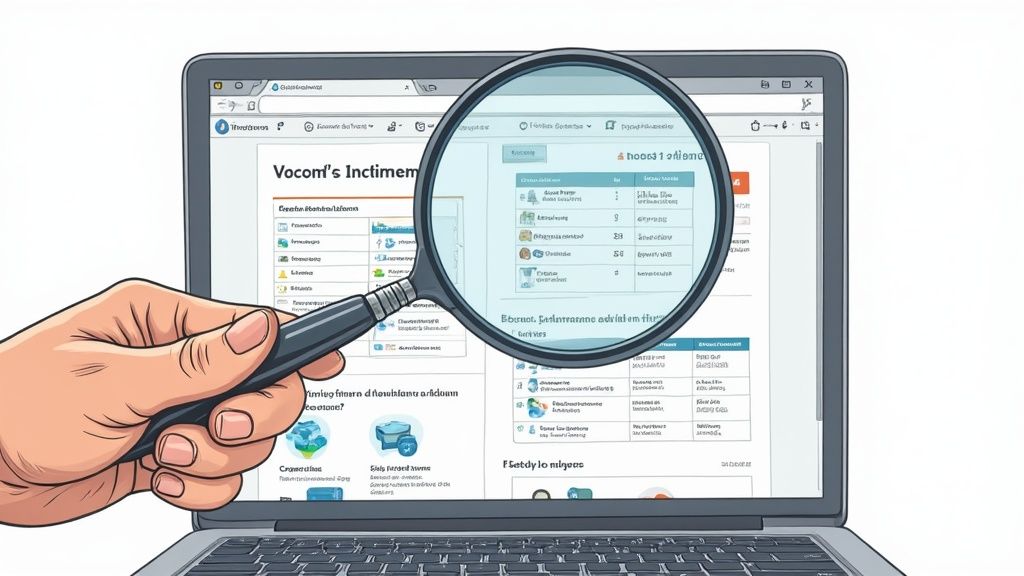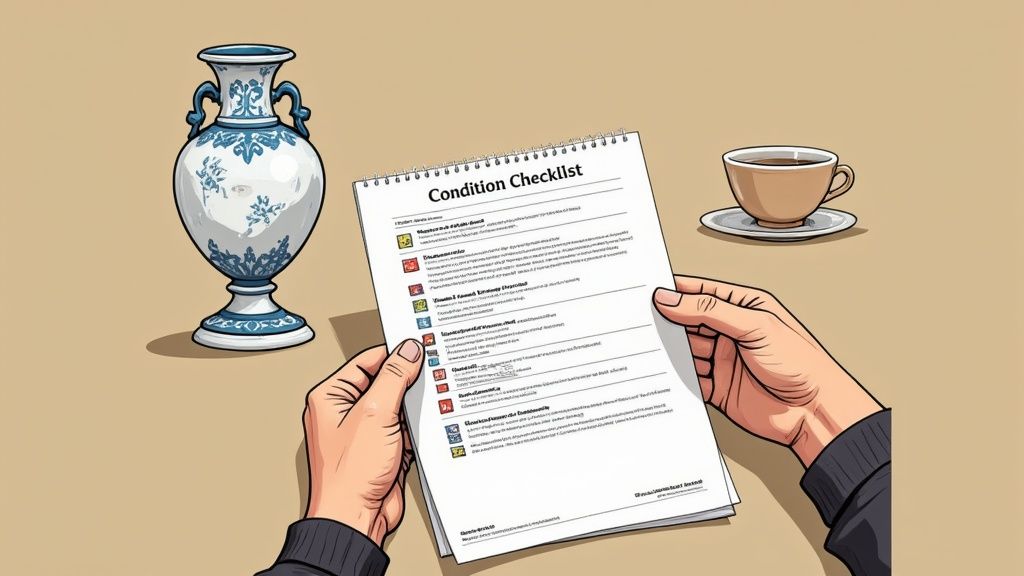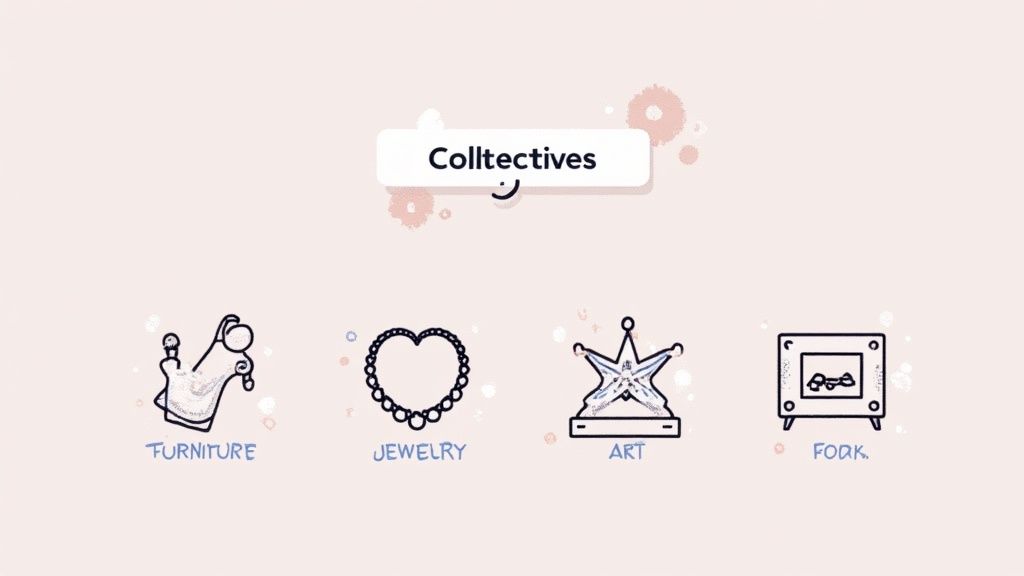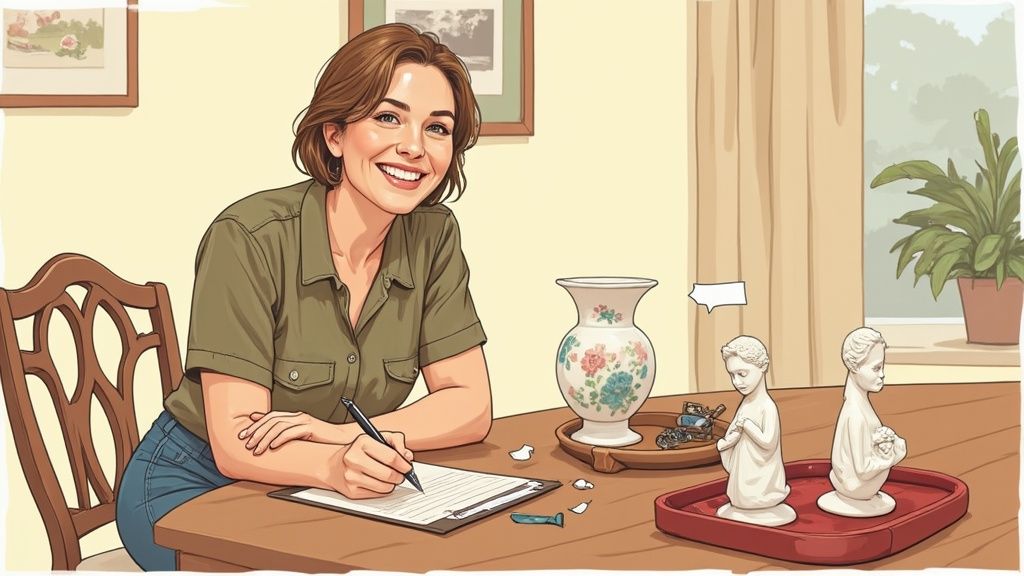The Real Numbers Behind Estate Sale Success
Let's be honest about the money side of estate sales. So many people go in with unrealistic expectations, thinking they'll make a fortune. I've seen it happen time and time again – families overvaluing their belongings and ending up disappointed. Pricing items right is a delicate balancing act. You need to find that sweet spot between what you think something is worth and what someone else is willing to pay. The difference between a $20,000 sale and a $5,000 sale? Often, it comes down to realistic pricing.
It's not just about the potential income, but also understanding the actual amount you’ll take home after commissions and fees. These costs can really eat into your profits if you're not prepared. Think of it like selling a house – you wouldn't ignore realtor fees and closing costs, would you? Estate sales are similar.
Commission Structures: A Closer Look
Commission structures are a key factor. Many estate sale companies charge a percentage of your total sales, often around 35%. That's a significant portion of your earnings. Imagine a gross sale of $10,000. After a 35% commission, you're left with $6,500. Knowing this upfront helps you price your items strategically from the beginning. It also motivates you to compare rates and negotiate. Even a small percentage difference can translate to thousands of dollars.
Understanding Overall Financial Returns
To price effectively, you really need to grasp the bigger financial picture of estate sales. Average gross sales can vary quite a bit. For instance, Estatesales.net found average gross sales were $18,565 in 2018, up from $11,249 in 2017. Nasdaq offers further insight. But remember, after commissions, the net proceeds are typically lower, often around $12,000.
Let's look at a potential breakdown to illustrate this:
Estate Sale Revenue Breakdown Comparison of gross sales versus net proceeds after commissions and fees
| Sale Component | Average Amount | Percentage of Total |
|---|---|---|
| Gross Sales | $18,565 | 100% |
| Commission (35%) | $6,498 | 35% |
| Other Fees (e.g., advertising, staffing) | $800 | ~4% |
| Net Proceeds | $11,267 | ~61% |
This table shows how various costs can affect your final profit. While gross sales might look impressive, the actual amount you pocket is considerably less after deductions.
The Power of Preparation
Don't underestimate the value of planning. A realistic budget, awareness of potential costs, and research into commission structures are essential for smart pricing. This is where a profit-first mindset comes in. By understanding these financial realities, you're already ahead of the curve, setting yourself up for a successful and profitable estate sale.
Reading Your Local Market Like a Pro
Knowing your local buyers is the secret weapon that separates successful estate sales from the so-so. I've seen beautiful antique furniture go unsold because the pricing was way off, while everyday items flew off the shelves because the seller understood their market. Trust me, this research is essential for pricing estate sale items effectively.
One of the best ways to learn local pricing is by attending other estate sales. Notice what sells quickly and what doesn't. This gives you valuable, real-time data on demand and pricing trends. It’s like free market research! If mid-century modern furniture is hot at local sales, you know you can price those pieces competitively.
Online resources are also a goldmine. Check out online marketplaces like eBay, Facebook Marketplace, and even Craigslist to see what similar items are selling for in your area. Don't just look at asking prices; focus on sold listings for a realistic view of market value. This competitive analysis will help you avoid both overpricing and underselling.
Understanding Seasonal Trends and External Factors
Timing is everything! Certain items are more in demand during specific seasons. Patio furniture and garden tools fetch higher prices in spring and summer, while holiday décor is popular in the fall and winter. Pricing strategically means considering these seasonal shifts.
Don’t forget external factors like economic conditions and even tariffs. For example, as of 2025, tariffs are expected to impact estate sales by influencing demand and profitability. Discover more insights on this here. This means sellers need to stay adaptable and informed.
Local Auctions and Antique Shops: Your Secret Weapons
Local auctions are another great resource for gauging market value. Attend a few and observe what items sell for and the level of buyer interest. This is especially helpful for antiques and collectibles where pricing can be a bit of a puzzle.
Similarly, browsing antique shops gives you an idea of how dealers price similar items. Keep in mind, antique shop prices are typically higher than estate sale prices, so adjust accordingly.
By using these research methods, you'll get a good grasp of your local market. This knowledge lets you price your items strategically, maximizing your profits and ensuring a successful sale. It’s about understanding what buyers want and what they'll pay – and sometimes, that’s more important than sentimental value.

Honest Condition Assessment Without Leaving Money Behind
Sentimentality can be a real budget-buster in estate sales. I've seen it firsthand – families pricing grandma's cherished furniture as if it just rolled off the showroom floor, while overlooking the hidden gems. The key to pricing estate sale items effectively? Objective condition assessment. Leave the emotions at the door and honestly evaluate the difference between normal wear and tear and actual damage.
This doesn't mean discarding everything with a scratch. A vintage dresser with minor imperfections might still be a hot ticket item, especially if it boasts a sought-after style. Buyers understand that older pieces come with a history. But that same dresser with a broken drawer or wobbly legs? That's a different story. Your pricing strategy needs to reflect these issues. Sometimes, a little repair work can significantly boost the final sale price.
Spotting Value Beyond Surface Imperfections
What some might call "flaws" can actually add character and value! Think about it: a chipped teacup from a beloved set might not be worth much individually. But for a collector trying to complete their set? It's a goldmine. This is where understanding your market becomes crucial. You might be interested in how to find the value of antiques.
On the flip side, that "just needs a little TLC" mindset can backfire. While some buyers relish restoration projects, significant repairs can deter the average estate sale shopper. Be upfront about the work involved. Overpricing a damaged item, hoping a handy buyer will swoop in, often leads to disappointment and unsold inventory.
Presenting Items Honestly and Effectively
Presentation is everything! Clean items thoroughly. Trust me, a little elbow grease goes a long way. Stage furniture strategically to highlight its best features. A small rug and a lamp can transform a worn armchair into a cozy reading nook.

Don't shy away from imperfections. A small sign acknowledging a chip or scratch demonstrates honesty and builds trust with buyers. This transparency can surprisingly boost sales by fostering confidence.
Remember, honesty is your best asset. Buyers appreciate transparency. By accurately assessing and presenting your items, you'll attract serious buyers, maximize your profits, and ensure a smooth and fair transaction for everyone.
Category-Specific Pricing That Actually Works
Pricing items for an estate sale? It’s definitely not a one-size-fits-all situation. What works for a vintage necklace won't necessarily work for a dining room table. Seasoned estate sale pros know this and adjust their pricing strategies accordingly. This means really understanding each category – from old books to fine art, dusty electronics to treasured collectibles. Mastering these differences is the key to maximizing your profits.
For example, books and linens often do well with volume pricing. Think about it – someone buying a set of vintage encyclopedias probably isn't going to haggle over a few dollars per book. Bundling these items encourages bigger purchases and helps clear out inventory fast. On the other hand, artwork and unique collectibles need individual attention. These pieces often require more research to pinpoint their real value and can often command higher prices. It’s all about understanding the buyer’s mindset: are they hunting for a bargain or a one-of-a-kind treasure?
Recognizing Research-Intensive Items
Knowing where to focus your research efforts is a game-changer. Some items justify deep dives, while others are better suited to a quicker, more competitive pricing approach. Vintage electronics, for instance, can often be priced by checking recent sales of similar models online. Platforms like eBay are a great resource for this. Spend your valuable research time on items where it really makes a difference, like antique furniture or rare collectibles. You might find our antique price guide helpful for these trickier items.
Strategic Grouping and Bundling
Strategic grouping and bundling can have a huge impact on your bottom line. Imagine a collection of vintage kitchenware. Pricing each item individually is a time suck and might not get you the most profit. Instead, create themed bundles: a baking set, a coffee and tea set, or a collection of vintage mixing bowls. This helps buyers visualize how the items work together, encouraging them to buy more.
Here's a quick look at how different categories might be approached:
To help illustrate this further, take a look at this comparison table:
| Item Category | Pricing Strategy | Research Time | Profit Potential |
|---|---|---|---|
| Books/Linens | Volume Pricing/Bundling | Low | Medium |
| Artwork/Collectibles | Individualized Pricing | High | High |
| Vintage Electronics | Competitive Pricing | Medium | Medium |
| Furniture | Individualized/Bundling (sets) | Medium-High | Medium-High |
| Kitchenware | Bundling/Themed Sets | Low-Medium | Medium |
This table highlights how the pricing strategy, research time, and profit potential vary significantly depending on the item category. As you can see, items requiring more research often have a higher profit potential, but balancing your time investment is key.
Identifying Premium Items
Let's be honest, not all items are created equal. Within each category, you'll find pieces that deserve premium placement and pricing. Maybe it's a first-edition book, a designer piece of furniture, or a rare collectible. These items should be showcased prominently and priced to reflect their unique value. This might involve more in-depth research, including checking auction results on sites like LiveAuctioneers and consulting with specialists. Learning to spot these high-value items is a skill honed with experience, but it's absolutely essential for maximizing your estate sale profits.
Using Auction Data and Competitive Intelligence Wisely
Knowing the market is key to smart pricing, but don't drown in data. I've seen folks spend hours researching obscure auction results for common items while ignoring local prices. It's like baking a cake with a recipe from another country – similar ingredients, maybe, but the measurements and techniques are totally off. You need to know when auction data is helpful and when it's just distracting noise.
Leveraging Auction Data For Estate Sale Pricing
Auction data can be insightful, especially for high-value or unique items. Let's say you're pricing antique jewelry. Maybe you’re wondering about its origins or value. Check out our guide on: How to Identify Antique Jewelry. A quick search on LiveAuctioneers or Inman can show recent sale prices for similar pieces, giving you a baseline for your pricing. International auction results can also hint at premium opportunities. High demand for art deco jewelry in London, for instance, could signal a similar trend locally.
However, relying only on auction data can be tricky. Auction prices swing wildly depending on the auction house, the day, even the bidders' moods. That $10,000 vintage watch at Sotheby's? It might only bring $2,000 at a local estate sale. The global auction market, though, can offer serious insights, especially the United States, which represents 31% of global auction sales value. Understanding U.S. auction trends provides a helpful benchmark. Discover more insights about the global auction market.
Monitoring Your Competition
Never underestimate checking out the competition. Attending local estate sales gives you a free look into buyers’ minds. Notice what’s flying off the shelves, what's sitting, and the general price range. This firsthand knowledge is crucial for your own pricing. If vintage furniture is selling fast nearby, that signals strong demand, justifying higher prices for your similar pieces. Conversely, piles of unsold books might mean you need to adjust your pricing or try bundling.
Balancing Broad Trends With Local Realities
The trick is balance. Use auction data and market trends as a starting point, then adjust for your local market. You want to price effectively within your specific situation. Don't let outliers throw you off. One high-value sale across the country doesn't mean you can duplicate that in your neighborhood. Concentrate on data relevant to your area and buyer demographics. By combining broader market knowledge with local insights, you’ll create a pricing strategy that attracts buyers and maximizes your sales.

Reading the Room and Adjusting Prices That Work
Pricing estate sale items is a bit like throwing a party. You can meticulously plan every detail, but you also have to be ready to adapt to the vibe of your guests. The same goes for your shoppers. Even with the best laid plans, you need to be flexible. Trust me, I've learned this firsthand.
The best way to gauge your pricing? Watch how people interact with your items. Are they picking things up, giving them a good once-over, and then putting them back down? Big red flag. Are dealers making repeated passes by a specific piece without committing? They’re probably hoping for a price drop. Notice some sections of your sale are getting less love than others? The pricing in those categories might be a bit high. These subtle cues are what you want to pay attention to – they're like secret whispers telling you what to do.
Strategic Price Adjustments Without Undermining Confidence
Changing prices mid-sale can feel a little nerve-wracking. You don't want to seem desperate or like your items aren't worth what you initially asked. The secret is to be smart about it. Look for buyer behavior patterns. If a few people show interest in something but balk at the price tag, a small discount can often be all it takes.
For instance, let's say you have a cool vintage lamp priced at $50. If people keep picking it up and putting it back, try knocking it down to $45 or $40. That little nudge can encourage a sale without significantly impacting your profit.
The Psychology of Effective Discounting
Knowing when to discount is just as important as knowing how much. Don’t immediately slash prices on the first day. Give people a chance to mull things over. I’ve seen a lot of successful sellers use a tiered discounting system. They might start with modest discounts mid-sale and then gradually increase the percentage as the sale goes on. This creates a sense of urgency without making everything feel instantly devalued.
Think of it this way: your early birds might be happy to pay full price for those one-of-a-kind treasures, while your bargain hunters will be patiently waiting for deeper discounts later on.
Navigating Bulk Buyer Negotiations
Dealers and resellers (your bulk buyers) can be great customers, but they’re also pros at haggling. Be ready to offer them discounts for large purchases, but don't sell yourself short. Say a dealer wants to buy your entire collection of vintage glassware. Consider offering a 10-20% discount, but set a minimum purchase amount. This way, you move a lot of inventory quickly and still make a decent profit. It's all about finding that win-win.
The Power of Standing Firm
Here’s a surprising tip: sometimes not discounting can actually help you sell more. If you have a truly unique or highly desirable item, sticking to your price can signal its value. This is especially true for antique furniture or collectibles where the condition and rarity justify a higher price. Holding your ground shows you’re confident and can attract serious buyers who recognize the item’s worth.
Finally, in those last few hours, create a real sense of urgency. Announce “last chance” deals and maybe offer bigger discounts to clear out what’s left. This generates a bit of excitement and encourages those last-minute impulse purchases, helping you maximize your sales potential right up to the end. Remember, estate sales are always changing. Being able to read the room, understand buyer psychology, and adapt your pricing is what makes a sale truly successful.
Your Estate Sale Pricing Success Plan

We've covered market research, checking item condition, and pricing tricks for different categories. Now, let's create a practical plan you can use. Consider this your personal guide to pricing estate sale items like a seasoned pro. No more guessing games or pricing panic – just real-world, actionable advice.
Creating Your Timeline and Priority Checklist
First, make a realistic timeline. Don't feel like you have to do everything at once. I always start with the big-ticket items – the furniture, artwork, or collectibles that could bring in the most money. These deserve your dedicated research time. After that, I move on to smaller categories like books, linens, and kitchenware. A simple checklist helps me stay on track.
Here's an example of how I might break it down:
- Week 1: Research and price high-value items (furniture, art, jewelry).
- Week 2: Price mid-range items (electronics, décor, smaller collectibles).
- Week 3: Price remaining items (books, linens, kitchenware) and finalize any bundling deals.
This phased approach gives you enough time to research the potentially high-profit items while efficiently pricing everything else.
Knowing When Enough Is Enough
One of the hardest things? Knowing when to stop researching. You could spend forever comparing prices and looking at auction results, but it's easy to get lost in the weeds. Here’s a tip: spend more research time on items with higher potential value. A rare antique chair needs more digging than a box of old paperbacks. Trust me.
Also, think about your local market. If you're in a smaller town, you might not have a lot of comparable sales data. Don't stress yourself out trying to find the exact same item sold across the country. Focus on what’s selling locally and price accordingly.
Troubleshooting Common Pricing Challenges
Even when you’ve done this a few times, you'll probably still run into pricing roadblocks. Unsure about an item's value? Get some expert advice. A quick appraisal can be a great investment, especially for unique or potentially valuable items. This gives you the confidence to price accurately and avoid costly mistakes.
What if you're emotionally attached to some items? This is when a friend can be a huge help. Ask them for an honest, objective opinion on pricing. Their fresh perspective can make a big difference.
By following this structured approach and tweaking it to your specific situation, you’ll confidently price your estate sale items, maximizing your profits and minimizing the hassle. Ready to jump into the fun world of antiques and collectibles? Download Curio today and start exploring!
